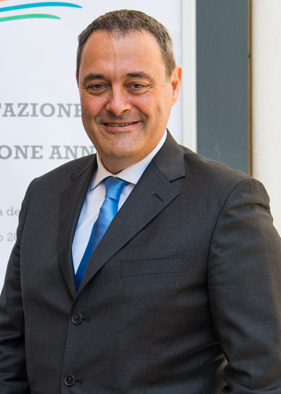April 2023, Year XV, no. 4
Stefano Besseghini
The Caretaker of Our (Cold) Winters
“Last summer we were ready when the race got underway to stock up on gas to get through the winter. We secured 2023 winter, but now we need to work on the 2024 winter.”
Telos: The Covid-19 emergency and the war in Ukraine have had a serious impact on the economy in general, and the energy sector was one of the hardest hit. Could you tell us about this crisis from your ‘privileged’ vantage point?
Stefano Besseghini: During 2021 and all throughout 2022, the prices of gas, which influence the prices of electricity, were higher and peaked between June and August of last year, when the situation deteriorated even further. First post-pandemic economic recovery, then the drop in Russian gas due to the war and finally drought all caused prices to spike to double what they had been in previous months and ten times what they had been in the last five years. All this was felt by the system, with an impact on industrial supply chains, supplies and citizen’s bills. It was a complicated situation, which at the end of 2022, started to present some serious challenges for the system.
However, we can say that this very long, unexpected crisis was dealt with quickly and responsibly by the various components of the Country system. Since prices started rising, the government has provided almost 50 billion euros in instruments to support general consumers and interventions aimed at bolstering energy-intensive industries and vulnerable families.
What is certain is that today the general conditions have changed and prices seem to be stabilising. This last winter’s mild temperatures also probably helped by keeping energy consumption low. But even though wholesale market prices are now showing signs of significant decreases, in family and business economies, energy costs are still quite high.
In fact, although the cost of energy has gone back down again, if you look at the overall economic picture, you see high inflation that wasn’t there at the beginning of the energy crisis. This means that, even though the final cost of light and gas on people’s bills went down at the beginning of 2023, they still haven’t gone back to pre-crisis levels.
Without lowering our guard, I think we can be moderately optimistic, because the outlook is more reassuring than it was a year ago after all. The same storage capacity that contributed last summer to causing gas prices to spike to 300€/MWh is less worrisome today.
It’s always hard to predict the future, but the situation doesn’t appear too complex in the near future. In this sector, there are two factors in our favour. The first is that the initial amounts that need to be stocked are definitely lower. The other is that, after the price cap agreement and in light of the EU’s plans to buy gas jointly starting in April, EU countries are more willing to coordinate. It took a year, which may seem like a long time unless you consider the interests at stake, but now it looks like competition over energy storages – which were a bit out of control and driven in part by last year’s crisis – is a thing of the past.
Italy is gearing up to safeguard itself from other emergencies by diversifying its flows and supplies and creating infrastructure, and we have to continue along these lines, be it gas or renewables, because this way we can all be more relaxed if times get tough again.
Our country has already done a lot to diversify its supply. In one year our energy dependence on Russia has dropped from 40% to 20%. At the same time, we are getting more and more energy from countries like Algeria, Norway and Azerbaijan, who we import far more gas from than in the past. I’ll also add that last summer we were ready when the race got underway to stock up on gas to get through the winter.
In particular, we are working to develop the role of regasification terminals. By the end of this year, Europe plans a 25% increase in the flow of imported LNG. In May the terminal in Piombino should be operative and will have a regasification capacity of 4.5 billion cubic meters per year. Soon another two or three terminals will also be fully operational and allow us to receive additional liquefied gas as an alternative to natural gas that travels via pipelines.
In the end, we can say that, in terms of energy, we secured 2023 winter, but now we need to work on the 2024 winter. If we manage to strengthen our infrastructure as we intend to, in a couple of years we could try and go down to around 30-35 euros/MWh.
The end of the protection scheme for the electricity market is drawing near, even for households. What is ARERA’s role, past and future, in ensuring this transition doesn’t negatively impact citizens?
The price protection scheme has come to an end gradually on the basis of size and awareness. After beginning years ago with large-scale businesses, in 2021 it was time for the SMEs. This year it is the turn of microenterprises and non-domestic users connected at low voltage, which also includes apartment buildings, with the transition set for 1 April.
For household electricity and gas, the protection scheme is set to end in January 2024. However, generally speaking, we should point out that, although the protection scheme will end, the free market is also regulated and ARERA’s and National Competition Authority’s controls will remain in place. So it won’t just be a free-for-all.
I’d also like to reiterate that over two-thirds of customers have already switched over to the free market on their own, and many of them are apartment buildings.
Going back to the 1 April deadline, remember that anybody who hasn’t chosen a free-market vendor will be moved to the Servizio a Tutele Graduali (Service for Gradual Protection), which ARERA set up to ensure a smooth transition, with vendors selected through public bidding procedures.
However, energy costs won’t change and will take into account the National Single Price, fees to cover supply and selling costs as well as a national component based on the price set during the bidding process. The other items on the bills won’t change: transport and meter management costs, system fees (which the State is paying now), taxes.
Then in order to help consumers make the best choice,we have set up the ARERA Offers Portal, the only independent public comparison tool where it is mandatory for vendors to include all their offers, even for apartment buildings. Like all consumer services, they are easy to reach from ARERA’s homepage by clicking on “Arera per il consumatore”.
One of the key points of the National Recovery and Resilience Plan (NRRP) is energy transition. What is ARERA’s role and its assessment of where things stand in the implementation of the Plan?
The NRRP specifically mentions ARERA among the enabling reforms. In the development of the NRRP, the powers of the various national regulators will be strengthened – ARERA, the securities market regulator CONSOB, the communications regulator AGCOM, the transport authority ART – while maintaining their structural and functional independence.
As for sectorial reforms, the focus is on hydrogen, with the sector regulated by ARERA. The role of hydrogen is gradually taking shape within the decarbonisation process. Right now ARERA’s role is to push hard so that the consumption and generation framework can quickly identify a technical and business model to prop up the whole mechanism.
The NRRP projects have probably been fragmented, as they typically are in Italy, and it would’ve been better to avoid this. On the topic of hydrogen, we need a taxonomy of “research, development and innovation”, seeing as they have different financing needs, different goals and different investment returns.
When ARERA comes up in conversation, people think energy. Yet it also works in many other areas, such as waste and water. Can you talk to us about any measures ARERA has worked on that might be of interest to us ordinary citizens?
ARERA was created for energy. Then over time it was tasked with regulating and controlling the water sector and finally the waste sector. Having a single regulator with an overall, across-the-board vision of the sectors is a response to the natural evolution of the sectors themselves, which are becoming more and more integrated. Now the waste sector dialogues with energy, water dialogues with energy and water with waste. So you can see how circularity has become an absolutely key issue.
The waste sector is extremely complex because it has a large labour component. Its industrial investment is definitely smaller, so it evades the rules and the regulation logic more easily. In August 2021 we defined the second tariff method, which puts us at the cutting edge of waste regulation in Europe.This mechanism has two essential features: symmetry, or rather, trying to do things so that, wherever things are working, regulation doesn’t limit development potential and the ability to increase sectorial transparency and the issue of infrastructure. The need for this infrastructure is specifically addressed in the NRRP. All the regulatory activity of this tariff method,valid until the end of 2025, specifically introduces the regulation of these plants. So we separated the plants into vertically integrated plants (i.e. the ones belonging to a vertically integrated operator) and supplementary facilities (i.e. ones where it’s good for them to be in the market). Finally, we left it up to the Regions to identify what we call “minimal” plants, or plants that close the waste cycle in a specific area.
Waste plant regulation that focuses specifically on closing the waste cycle is totally new. The second tariff method is also a flexible instrument that allows both the competent local administrations and the operators to offer users adequate services at sustainable costs. However, this same instrument allows ARERA to step in if the method is not being applied.
As for water, the most critical thing we need to address is leakage in the water network. The situation is critical, but things have improved if you think that we’ve gone from 43% to 40% leakage, also thanks to ARERA’s efforts. Since 2012 ARERA has taken over competence in this sector and has set some improvement targets aimed at reducing leakage.
The reversal of this trend allows us to be more optimistic about the future, considering that many utilities are investing throughout Italy to reduce leakage. However, the situation is still dramatic. It’s a long road, but it will bring us closer to the best European countries like Germany and Denmark, where leakage mustn’t and can’t exceed 1% per year. This goal is a huge challenge for ARERA and will drive all providers to improve quality standards for the service.
Marco Sonsini
Editorial
Whether they are for gas, electricity, water or waste, when bills show up, no family is ever very happy. However, it sure didn’t take much for this slight nuisance to turn into a total nightmare. 2022 truly was an annus horribilis, as confirmed by our April guest for PRIMOPIANOSCALAc Stefano Besseghini, President of ARERA, the Italian Regulatory Authority for Energy, Networks and Environment. One of those people who ordinary citizens never would have dreamt of knowing. However, since last year Besseghini’s statements have offered both realism and reassurance, for all of us. Never has a president of a regulatory body been so present in the media, and for good reason. Who better than a technical specialist who has dedicated his whole life to energy - and knows all its mysteries -is able to provide accurate answers to citizens like me, who have enough trouble reading their bills, much less understand a massive energy crisis, how long it will last and how it will impact our lives? No one.
In his interview, Bessenghini gives us a good explanation of everything that has been done to soften the blow of the gas crisis, even though the positive impact has been watered down by the rising inflation. Let’s face it, the economy is going through a rough patch, and if the institutions weren’t there poised to provide a buffer, we’d all be up the creek.
Bessenghini tells us that “this very long, unexpected crisis was dealt with quickly and responsibly by the various components of the Country system. Since prices started rising, the government has provided almost 50 billion euros in instruments to support general consumers and interventions aimed at bolstering energy-intensive industries and vulnerable families.”
Then he tells us about the role ARERA played in regulating the waste sector, which he defines “extremely complex because it has a large labour component. Its industrial investment is definitely smaller, so it evades the rules and the regulation logic more easily.”
Then he goes on to talk about another hot-button topic: water. Besseghini reminds us that “the most critical thing we need to address is leakage in the water network. The situation is critical but things have improved if you think that we’ve gone from 43% to 40% leakage.”
Drought has become such a problem that, in the 6 April Council of Ministers, athe Decree-law “Drought” was approved “that introduced urgent measures to prevent and contrast drought and to strengthen and upgrade water infrastructure.” In Italy this sector is governed by a plethora of agencies, authorities, concession holders, service providers and commissioners.
The only exception is the integrated water service, i.e., public aqueduct, sewer and purification services, which comprise only 20% of total water use and is regulated by the ARERA of our guest, Stefano Besseghini! So what about the other 80%? It hasn’t even been mapped out. The Decree-Law will attempt to introduce a bit of order with the usual task force and a National Commissioner. Let’s hope that’s enough!
On the 2023 covers of PRIMOPIANOSCALAc, we use the faces of our guests to create something similar to museum merchandise. Every month we personalise an item with the black and white image of our guest. This way, a t-shirt, magnet or shopper becomes a memory, an experience, a symbol. Our guests become icons, just like museum pieces such as Da Vinci’s Vitruvian Man, Van Gogh’s sunflowers, Michelangelo’s The Creation of Adam in the Sistine Chapel… They are so iconic, we have decided to treat them like pop stars, singing on social media. For Besseghini we have chosen a power bank, which represents energy (actually, gas), something he endeavours to stock up on to protect us against the winter cold. The song in the musical version of the cover, another important feature of our 2023 edition, is “7 Seconds”. We chose this song because “Battle is not over, even when it's won.”
Mariella Palazzolo

Stefano Besseghini has been the President of ARERA, the Italian Regulatory Authority for Energy, Networks and Environment since August 2018. In September of that same year, he was appointed Vice-President of MEDREG, the Association of Mediterranean Energy Regulators.
Besseghini holds a Degree in Physics from the University of Milan, where he also earned a specialisation in Materials Science and Technology.
He was appointed CEO of RSE, Ricerca Sistema Energetico in November 2010 and was reappointed in May 2011. In June 2014 in addition to serving as CEO, he also became President, until he took his position at ARERA.
He helped to develop the innovation hub at Politec Valtellina, where he served as CEO from 2007 to 2011. Subsequently, he served as President of Politec Banda Larga.
He has always been connected to the world of research and worked for the National Research Council (CNR). In 1996 was head of the CNR in Lecco, one of the most active centres in Italy in the area of physical metallurgy. He has headed various research projects both national and internationally, always with a view to interacting with the industrial system. This experience enabled him to achieve some successful technology transfer cases.
He has co-authored seven patents, published 80 articles in international journals and spoken at many national and international conventions. He has also assessed international, national and regional research projects in additional to acting a referee for international journals.
Besseghini was born in the province of Sondrio and is 58 years old. He is married and has a son.
Marco Sonsini







SocialTelos